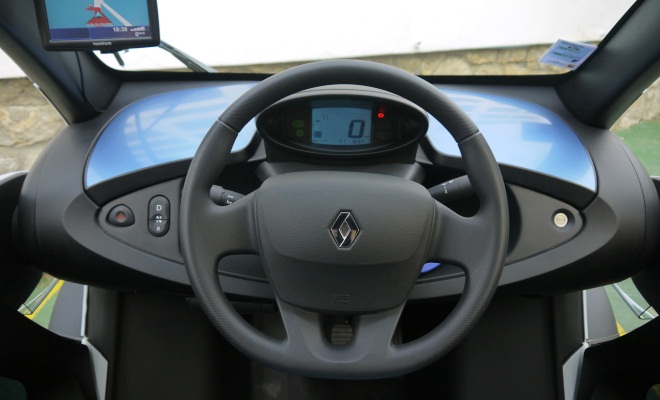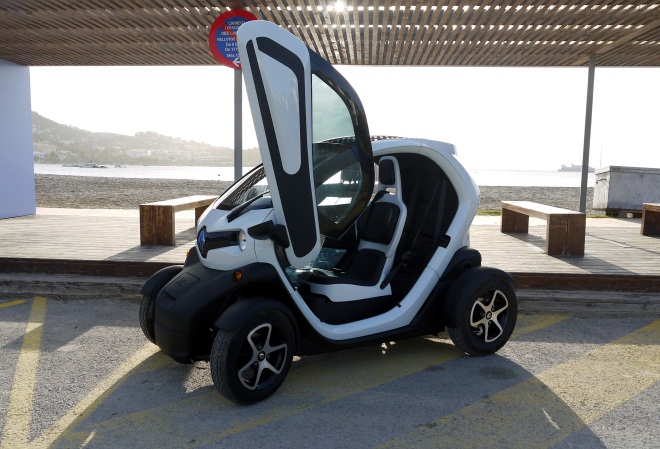
About 18 miles into my first drive in Renault’s remarkable Twizy I stopped to take photographs, borrowing a rustic shed on the island of Ibiza as a contrasting backdrop for my plastic-panelled electric pod. A wizened local, presumably the owner of the dilapidated lean-to I’d commandeered, wandered over as I took my first snaps. He stuck his hands in his pockets and asked a question.
I have no idea if he asked what the hell I was doing or what the hell I was driving, as I don’t speak Spanish and my English met blank stares. But judging from his close inspection he seemed fascinated by the Twizy, confused to find a steering wheel rather than handlebars, bemused by its scissor-action doors, surprised to discover a passenger seat, and taken aback when I strapped in and moved off without a sound. I think he expected to hear the rattling clatter of a two-stroke engine, rather than the imperceptible whine of a motor. “It’s electric!” I said, as I squeezed a neat three-point turn into his tiny yard, and drove out onto the public highway. He waved a friendly farewell – or possibly shook his fist – I can’t be sure.
What I am certain about is the little Twizy’s unparalleled capacity for attracting attention. Wherever I stopped during two days of tests, bystanders bee-lined for the parked Twizy and gawped at it, pawed at it, or even climbed aboard when my back was turned. It may have doors (they’re optional) but they don’t lock, so onlookers are as free to get in as they are to squat on a parked scooter.

Inside, interlopers found a very simple interior that’s permanently open to the elements. Both doors scissor easily open in Lamborghini fashion, but there the resemblance to exotic high-speed machinery ends. The doors feel light and flimsy, don’t make an airtight seal at the edges, and don’t feature any window glass. Every trip in a Twizy is a blustery, wind-chilled affair. Even in Ibiza in the spring, fingers verged on numb as the sun’s warmth drained in the evening. In Britain, in winter, you’d need to dress for hiking in a gale.
There’s no call for a motorcycle helmet, though, as the Twizy provides a roof, a frost-free heated windscreen, an airbag and enough structural integrity to survive a 50km/h (30mph) frontal impact with a bit of minor bending to the chassis. The crash test was voluntary – the Twizy is legally classed as a four-wheeled motorcycle and doesn’t have to pass any collision tests at all. A side impact test might not be so pretty, but then nobody will buy a Twizy for its safety and solidity.

You might buy one for fun, though. The Twizy may top out at just 80km/h (50mph), but at any speed it offers more thrills than I’ve found in any car except perhaps a Caterham 7. People talk about sports cars offering a direct connection with the road, but in the Twizy you can literally hear the tyres working – a sort of squelching sound that builds as you round a bend. You can detect a change in pitch as the tyres begin to scrabble for grip at speed, even as the unassisted steering lightens up.
The 13-inch tyres have been specially designed for the Twizy, and they are noticeably more narrow at the front – the rears are 145mm wide and the fronts just 125mm, irrespective of whether you choose steel or alloy wheels. This uneven arrangement is to ensure predictable front-wheel-drive-style understeer as grip runs out, despite the rear-wheel-drive nature of the Twizy. The Smart ForTwo has a similar rear bias in rubber for the same reason. It would certainly be interesting to discover how the Twizy might handle with the wheels swapped front to back.
Alongside the tyres, Twizy pilots get to hear exactly what the rear-mounted 13kW (17bhp) electric motor is up to. The car might be almost silent from the outside but a rising whine steadily fills the cabin as you speed up, competing with wind noise for dominance. It’s not restful but neither is it particularly unpleasant.

Setting off requires a precise sequence of events. First, switch on with the key as you normally might. The LCD instrument panel will dance through a startup procedure, before finally settling a couple of seconds later. Only then can you give the key a further twist – just like starting an engine – to fully prime the Twizy. Jump the gun and you’ll enter a digital no-man’s land and will have to start over.
Once the instruments give the green “Go” light, you are free to select a gear using the two-button transmission controller. Press D for drive, R for reverse, or both together for neutral. You can then release the handbrake, which is hiding under the dash. But first press the brake pedal firmly enough to hear a click, or the lever won’t budge.
It sounds like a palaver and it is – I kept trying to rush the process and invariable made it take twice as long.

Once you finally get going, acceleration feels brisk from a standstill but sensations of thrust quickly wane. Getting to full pelt takes half a minute or so, and at an indicated 84km/h (52mph) a speed limiter blunders in to slow you down a bit.
While I wouldn’t want to take a Twizy onto a motorway, it felt bearable on dual carriageways although it does wander when faced with crosswinds or the bow-waves of overtaking artics.
The unassisted brakes, linked to discs all round, require a firm foot but are more than adequate for stopping the 450kg Twizy in a hurry. Similarly the manual steering may feel a little heavy to drivers weaned on powered everything, but you couldn’t ask for more feel.
Before I drove the Twizy I’d read that it had a rock-hard ride. That’s not quite the case – it’s firm and fidgety but it’s only really uncomfortable over harsh speed bumps or brutal pot holes. The suspension features thick anti-roll bars front and rear, designed to curtail leaning in bends, but they also rob the Twizy of any softness.
Bearing in mind the thin, waterproof padding on the plastic seat, comfort isn’t too bad. I’d have liked some lumbar support – your lower back is braced by the thin air between cushions – particularly given that you can’t adjust the seat’s rake. The seat does slide to and fro sufficiently for tall or short pilots, but the steering wheel is fixed. The door mirrors, meanwhile, are adjusted by a simple prod of the glass with your fingertips. There’s no central mirror, and no vanity mirrors either as there are no sun visors to put them in.

Rear accommodation is not quite as cramped as it might appear, but it is awkward to get in and even trickier to climb out, mostly because the front seat won’t tip forward. I didn’t try it on the move, but I imagine you wouldn’t want to travel back there if you treasure a neat and tidy hairstyle.
Around town, the Twizy was predictably joyful – scampering away from the lights and flitting in and out of tiny gaps. It’s not quite narrow enough to jump queues in motorcycle style, but it ought to be easy to find a parking space, particularly as you can slide in nose to the kerb in quarter-sized spaces and still climb out thanks to the scissor doors.
As a safety reminder, the Twizy starts to squawk whenever it’s held motionless on the brake for more than three seconds, which can get annoying. The only way to silence this screech is to select neutral or to creep slowly forward. I wound up braking early for red traffic lights to try to avoid drawing to a stop, which as a bonus is an excellent tactic for extending range.

Talking of which, the official range may be 100km (62 miles), but venture beyond an urban 30mph zone and you’ll be lucky to travel 60km (37 miles) before range anxiety steers you firmly towards a socket. The hard-wired charging cable lives under a little flap in the nose, alongside the screenwash bottle, and a full charge of the 6.1kWh battery takes 3.5 hours.
I started my test in a £6,950 Twizy Colour edition on steel wheels, with the £545 addition of doors. On day two I switched to a top-of-the-range Technic boasting alloys and metallic paint, which costs from £7,400 without doors. Both felt identical to drive, and every Twizy requires an additional monthly payment to lease the battery of between £45 and £67 depending on contract length and annual mileage.

Having sampled two Twizies and been seduced by their uncomplicated charms, I don’t think I would bother with fripperies like the £195 transparent roof. I’d go for base-model Urban spec at £6,690, with just a pair of doors bringing the tally to £7,235.
Yes, you could buy a small conventional city car for that outlay. But no, you won’t have nearly as much fun.
Renault Twizy review – Colour and Technic editions
11 April 2012
Read more about: electric cars Renault small cars test drives Twizy



